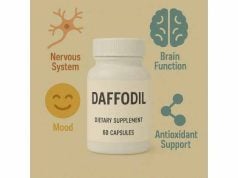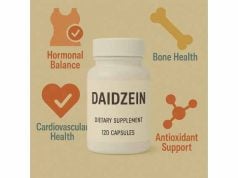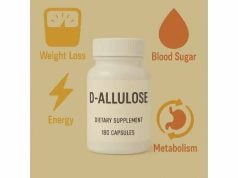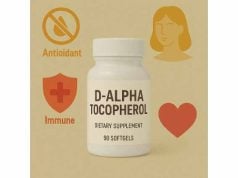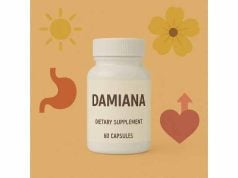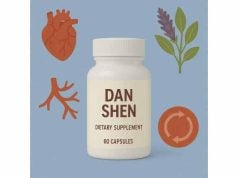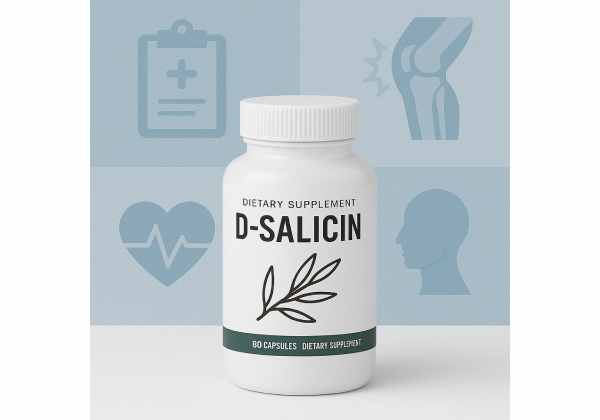
D-salicin is a naturally occurring compound best known from white willow (Salix alba) and a few other plants. In the body it acts like a “pro-drug,” converting to salicylic acid—the same active family that inspired modern aspirin. People turn to D-salicin for short-term relief of musculoskeletal pain and stiffness, particularly in the back and joints, and for its modest anti-inflammatory effects. Standardized extracts allow you to know how much salicin you are getting, and clinical trials have used daily intakes that are practical for supplements. Still, salicylates are not risk-free. They can irritate the stomach, interact with blood thinners, and are inappropriate for children and certain adults. This guide translates the evidence into plain language so you can weigh benefits and risks, see how dosing works, and decide whether D-salicin fits your situation.
Essential insights for D-salicin users
- May reduce short-term musculoskeletal pain and stiffness in some adults.
- Typical supplemental intake is 60–240 mg salicin per day, taken with food.
- Avoid with anticoagulants, salicylate allergy, ulcers, or upcoming surgery.
- Not for children or teens with viral illness; avoid in pregnancy and breastfeeding.
- Choose standardized extracts (e.g., 15–25 % salicin) from tested, reputable brands.
Table of Contents
- What is D-salicin and how it works
- Evidence-based benefits for pain and inflammation
- Forms, quality, and how to use it
- How much D-salicin per day
- Side effects, interactions, and who should avoid
- What the research says and key limits
What is D-salicin and how it works
D-salicin (often just “salicin”) is a plant-derived β-D-glucoside of salicyl alcohol. It naturally occurs in the bark of willow (Salix spp.), poplar, and meadowsweet. When you swallow salicin, enzymes in the gut and liver split off the sugar (glucose) and oxidize the remaining part to salicylic acid. That conversion is the key: salicylic acid is responsible for most of salicin’s biological effects.
Mechanism, in plain terms. Salicylic acid helps dampen the body’s production of pro-inflammatory prostaglandins. It does this by inhibiting cyclooxygenase (COX) pathways and by modulating NF-κB signaling—biochemical routes that drive pain and swelling. Unlike aspirin (acetyl-salicylic acid), salicylic acid does not irreversibly acetylate platelet COX-1, so its antiplatelet effect is far weaker and less predictable. That’s why D-salicin should not be viewed as an aspirin substitute for heart health.
What it’s used for. Traditional use centers on aches, fever, and rheumatic discomforts. Modern supplements—usually white willow bark extracts standardized for salicin—are marketed for short-term relief of low back pain or osteoarthritis symptoms, as well as everyday strains from activity.
How quickly it works. After ingestion, salicylic acid levels rise over a few hours, with steady symptom effects typically noticed the same day to within a week of consistent use. Because the effect is modest, people sometimes combine salicin-containing products with non-drug measures like rest, heat, or physical therapy.
Potency versus aspirin and NSAIDs. Salicin’s potency per milligram is lower than typical over-the-counter NSAIDs. Clinical trials that showed benefit used known salicin amounts, not crude bark powder of unknown strength. That distinction matters: plant material varies widely, and only standardized extracts let you translate label dose to the salicin amounts studied.
Terminology you might see. Labels may list “white willow extract,” “Salix alba extract,” or “salicin (from willow bark).” The active salicylate is the same family, but product quality and salicin content differ. Some products list “salicylic acid” directly—those are not the same as D-salicin and can have different safety profiles.
Bottom line. D-salicin is a natural salicylate that the body turns into salicylic acid. Its main role is short-term symptomatic relief of musculoskeletal pain. It is not a cure for underlying joint disease, and because it’s a salicylate, the usual cautions for that class apply.
Evidence-based benefits for pain and inflammation
Low back pain. Randomized controlled trials and systematic reviews have found that willow bark extracts standardized to 120–240 mg salicin per day can reduce short-term pain intensity in adults with acute or chronic low back pain compared with placebo. Improvements are often noticeable within 1–2 weeks of daily use. The certainty of evidence is moderate at best due to small study sizes and variable methodology, but the direction of effect favors pain reduction and reduced “rescue” medication use.
Arthritis symptoms. A recent meta-analysis pooling randomized trials in arthritis reported that willow bark—again standardized to salicin—was associated with improvements in pain and physical function versus placebo, without a higher rate of overall adverse events in the short term. For knee osteoarthritis, some participants also reported better stiffness scores. Importantly, these trials evaluated symptom relief, not structural joint change.
Inflammation pathways. Preclinical research continues to map how salicin-derived salicylic acid modulates inflammatory signaling. In cartilage models, salicin has been shown to influence ER-stress signaling (e.g., the IRE1α–NF-κB axis), offering a plausible biological rationale for symptom benefits in joint conditions. These experiments inform mechanism but don’t replace clinical outcomes.
Everyday aches and exercise recovery. Although robust athletic-specific trials are limited, the general anti-inflammatory effect of salicylates suggests a role for occasional post-exertion soreness. When considering this use, weigh the same stomach and bleeding cautions that apply to salicylates in general, especially if you also take other NSAIDs.
How benefits compare to NSAIDs. Head-to-head comparisons are scarce. In one early trial, standardized willow bark extract produced pain relief similar to a low dose of a prescription COX-2 inhibitor. This doesn’t mean willow is equivalent to modern NSAIDs across conditions or doses; rather, at the specific doses and timeframes studied, symptom improvements were clinically noticeable for some people.
Who seems to benefit most. Adults with intermittent musculoskeletal pain who prefer botanical options and are not at risk for salicylate-related adverse effects. Benefits are modest; expectations should be realistic, and non-pharmacologic measures (strengthening, mobility work, pacing) remain first-line for many pain syndromes.
What it does not do. D-salicin has not been shown to prevent cardiovascular events, reverse arthritis, or provide long-term disease modification in humans. If you need anti-platelet therapy or directed arthritis management, use guideline-recommended medications and consult a clinician.
Forms, quality, and how to use it
Forms you’ll see.
- Standardized extracts of white willow bark (capsules, tablets) listing salicin content (e.g., “15–25 % salicin”).
- Tinctures or teas made from bark—harder to dose precisely due to variable extraction.
- Blends that combine willow with other botanicals (e.g., devil’s claw, turmeric). These complicate dosing and safety assessment.
Reading a label. Look for:
- Declared salicin per serving. This is the number that should align with clinical dosing ranges (e.g., 60–240 mg/day).
- Standardization statement (e.g., “standardized to 15 % salicin”).
- Third-party testing (USP, NSF, or ISO-accredited labs) for identity, potency, and contaminants (heavy metals, pesticides).
- Clear allergens and excipients. Avoid products with undisclosed “proprietary blends” that obscure salicin content.
Translating extract strength to salicin.
If a capsule contains 500 mg of extract standardized to 20 % salicin, it provides 100 mg salicin (500 mg × 0.20). To reach 120 mg/day, you’d take a bit over one such capsule (practically, two smaller 60 mg salicin servings split with meals). For 240 mg/day, two of those 100 mg-salicin capsules plus a smaller serving would reach target. Because products vary, always calculate based on the stated salicin.
How to take.
- With food to reduce stomach upset.
- Split doses (morning and evening) can improve tolerability for sensitive stomachs.
- Short-term courses (days to a few weeks) are typical; reassess if no improvement in 7–14 days.
Combining with other measures. D-salicin pairs well with non-drug strategies: activity modification, heat/ice, progressive exercise, ergonomic changes, and sleep support. If you’re already under care for pain, let your clinician know before adding any salicylate-containing supplement.
Quality pitfalls. Bark powders without standardization can under- or overshoot salicin content. Teas and tinctures vary with steep time, plant part, and solvent strength. For predictable dosing—and safer decision-making—standardized extracts are preferable.
Who should get professional guidance. Anyone with a bleeding risk, gastrointestinal disease, chronic kidney disease, liver disease, diabetes on multiple medications, or a history of aspirin-sensitive asthma should talk with a clinician first. The same applies if you are pregnant, trying to conceive, or breastfeeding.
How much D-salicin per day
Evidence-aligned adult range. Clinical studies of willow bark for pain most often used 120–240 mg salicin per day, taken in one or two divided doses with meals. Some products provide 60 mg/day for milder discomfort or for individuals testing tolerance, but the more consistent effects in trials appeared at 120–240 mg/day.
Duration. Use the lowest effective dose for the shortest necessary time. For episodic back or joint pain, many people trial 7–14 days, then taper or stop if symptoms ease. Long-term, continuous use raises the likelihood of gastrointestinal irritation and other salicylate-related effects and should be supervised.
Dosing examples (standardized extracts).
- If your capsule is 400 mg extract at 15 %, that’s 60 mg salicin. Two capsules per day ≈ 120 mg salicin.
- If your tablet lists 120 mg salicin per tablet, one tablet daily hits the lower evidence-based range; two would reach 240 mg (do not exceed label directions without advice).
- Liquid extracts vary; only use if the label clearly states salicin mg per mL.
Timing tips.
- Take with or after food.
- Avoid bedtime dosing if you notice reflux.
- Hydrate well and avoid alcohol on dosing days to reduce GI irritation.
Do not combine with other salicylates or NSAIDs unless a clinician explicitly says it’s safe. That includes aspirin, bismuth subsalicylate, and OTC pain relievers like ibuprofen or naproxen; stacking increases GI and bleeding risks.
When to stop and seek care.
- Black or tarry stools, vomiting blood, or new/worsening stomach pain.
- Easy bruising, nosebleeds that are hard to stop, or unusual fatigue.
- No improvement after two weeks of correct use.
Special populations.
- Older adults (65+): start low (e.g., 60–120 mg salicin/day) and monitor closely.
- Renal or hepatic impairment: avoid unless a clinician oversees use.
- Athletes on scheduled anti-doping medications: verify ingredients to avoid unlisted stimulants in blends; choose single-ingredient, tested products.
Side effects, interactions, and who should avoid
Common side effects (usually dose-related).
- Stomach discomfort, heartburn, or nausea.
- Mild dizziness or headache in sensitive users.
- Skin rash in those with salicylate sensitivity.
Serious but less common risks.
- Gastrointestinal bleeding or ulcers, especially with higher doses, long durations, alcohol use, or a history of GI disease.
- Bleeding tendencies, since salicylates can impair platelet function (though less potently than aspirin).
- Kidney stress in predisposed individuals (dehydration, pre-existing kidney disease).
- Allergic reactions in people with salicylate intolerance or aspirin-exacerbated respiratory disease (asthma with nasal polyps).
Drug and supplement interactions.
- Anticoagulants/antiplatelets (e.g., warfarin, apixaban, clopidogrel): increased bleeding risk.
- Other NSAIDs or salicylates (aspirin, bismuth subsalicylate): add-on GI/bleed risk—avoid stacking.
- Corticosteroids, SSRIs/SNRIs, and alcohol: additive GI bleed risk.
- Herbals with antiplatelet activity (ginkgo, high-dose garlic, ginseng): theoretical additive effects.
Pregnancy and breastfeeding. Avoid D-salicin during pregnancy unless a clinician specifically advises otherwise for a defined indication. During breastfeeding, authoritative resources recommend avoiding willow bark because salicylate enters breast milk and safer alternatives exist for pain and fever.
Children and teens. Do not give salicylates (including salicin-containing products) to children or adolescents with viral illnesses because of the association of salicylates with Reye syndrome. When in doubt, consult a pediatric clinician.
Who should not use D-salicin.
- History of ulcer disease, GI bleeding, or inflammatory bowel disease flare.
- Bleeding disorders or planned surgery/procedures (stop well in advance per clinician guidance).
- Severe kidney or liver disease.
- Aspirin/salicylate allergy or asthma exacerbated by aspirin.
- Pregnant or breastfeeding individuals unless medically advised.
Practical safety tips.
- Choose standardized, third-party tested products.
- Start at the low end of dosing and monitor for stomach symptoms.
- Keep a single pain journal to avoid inadvertently mixing multiple salicylate sources.
What the research says and key limits
What is relatively solid.
Systematic reviews of randomized trials suggest that standardized willow bark extracts delivering ~120–240 mg salicin/day can provide short-term pain relief for low back pain and arthritis symptoms in some adults. Across these trials, adverse event rates were not higher than placebo for short durations, and GI complaints were the most frequent issues. This aligns with long experience using salicylates for discomfort.
What remains uncertain.
- Long-term safety and efficacy. Most trials last 2–6 weeks. We lack robust data on continuous use beyond that window.
- Head-to-head comparisons. Evidence directly comparing D-salicin with modern NSAIDs at equivalent effect levels is sparse.
- Disease-modifying effects. Preclinical studies show intriguing anti-inflammatory pathway modulation (such as IRE1α–NF-κB signaling in cartilage), but no human trials confirm structural joint protection.
Dose matters. Benefits were tied to known salicin milligrams rather than unspecified bark amounts. Products that do not state salicin content make the evidence hard to apply.
Population matters. Trials enrolled adults with back pain or osteoarthritis; results shouldn’t be extrapolated to children, pregnancy, or complex pain syndromes without medical guidance.
Quality matters. Botanical identity, extraction method, and contaminant control vary across brands. Risk assessments have flagged the need to monitor heavy metals (e.g., cadmium) and to keep supplemental intakes within studied salicin ranges—another reason to choose reputable manufacturers.
How to use the evidence.
If you’re an adult with episodic musculoskeletal pain, prefer plant-based options, and have no salicylate-related risk factors, a time-limited trial of a standardized willow bark extract that provides 120 mg salicin/day, titrating to 240 mg/day if needed and tolerated, is consistent with available evidence. If symptoms persist beyond a couple of weeks, or if red-flag symptoms (fever, trauma, radiating leg pain, weakness, bowel/bladder changes) are present, seek medical evaluation rather than escalating supplement doses.
References
- Willow Bark (Salix spp.) Used for Pain Relief in Arthritis: A Meta-Analysis of Randomized Controlled Trials 2023 (Systematic Review)
- Herbal medicine for low‐back pain 2014 (Systematic Review)
- Risk assessment of white willow (Salix alba) in food 2018 (Risk Assessment)
- Willow Bark – Drugs and Lactation Database (LactMed®) 2024 (Guideline)
- The natural product salicin alleviates osteoarthritis progression by binding to IRE1α and inhibiting endoplasmic reticulum stress through the IRE1α-IκBα-p65 signaling pathway 2022 (Mechanistic/Preclinical)
Disclaimer
This article provides general information about D-salicin and is not a substitute for personalized medical advice, diagnosis, or treatment. Salicylates can interact with medications and may be unsafe for some people. Always consult a qualified health professional before starting, stopping, or combining supplements, especially if you are pregnant, breastfeeding, under 18, scheduled for surgery, or taking anticoagulants or other pain medicines.
If you found this guide useful, please consider sharing it on Facebook, X (formerly Twitter), or your favorite platform, and follow us for future evidence-based updates. Your support helps us continue creating high-quality, reader-first content.

